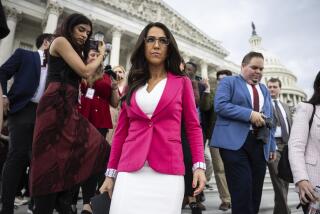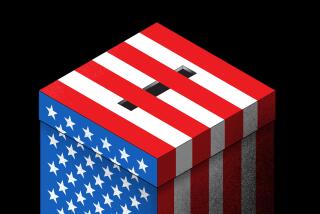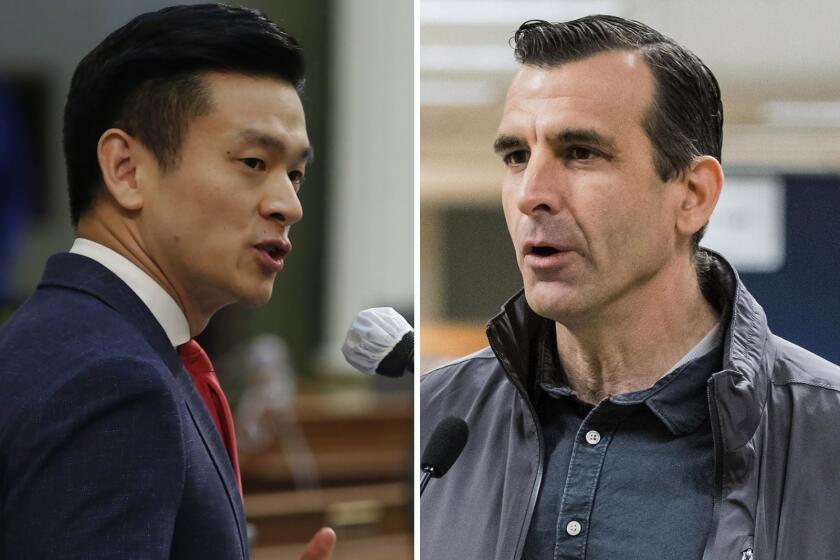Clearing the Road for Pet Projects
Casino operators, land developers, museum boosters and a major private university, among others, have poured millions into a November ballot initiative that would funnel tax dollars into their favorite projects in the name of easing freeway congestion.
Proposition 51 would take car sales taxes that normally help pay for prisons, parks, health care and other government services and use them to finance dozens of projects, including a rail line with stops at an Indian casino, golf cart paths for a gated retirement community, fuel-efficient boats for Lake Tahoe and a railroad museum addition.
For the record:
12:00 a.m. Sept. 19, 2002 For The Record
Los Angeles Times Thursday September 19, 2002 Home Edition Main News Part A Page 2 National Desk 15 inches; 569 words Type of Material: Correction
Proposition 51--A story in Section A on Sept. 9 about Proposition 51 incorrectly said the measure would establish regional boards to purchase and manage undeveloped land. Instead, existing agencies would be used for that purpose. The story also incorrectly quoted budget analyst Jean Ross as saying the “state never takes in less money from one year to the next.” She said that occurs “rarely,” rather than “never.”
The proposition, titled the Traffic Congestion Relief and Safe School Buses Act, guarantees 30% of state motor vehicle sales taxes would be set aside for road and transit projects and a smattering of land conservation grants.
In 2003-04, state analysts predict that would translate into $870 million. Of that amount, $228 million would be allocated as seed money to dozens of earmarked projects, including $183 million for Southern California. The remainder of the money would be divided among state agencies, which in turn would divide the money among California counties for transportation or conservation projects.
The sponsor of the proposition is the Planning and Conservation League, a Sacramento-based lobbying organization whose leaders say they want to protect the environment. The measure, which would go into effect Jan. 1, has split California’s environmental community and angered some legislators, who complain that it would force cuts to other programs to pay for projects that have not gone through the usual process for evaluating and selecting transportation proposals.
“This thing earmarks projects that cater to contributors’ interests. It will sacrifice kids and the poor so that people have a nice ride from L.A. to a casino, for God’s sake,” said Sen. John Vasconcellos (D-Santa Clara), a 36-year veteran of the Legislature and one of its leading experts on government finance.
The sponsor of Proposition 51 acknowledged that many projects were selected with an eye toward getting contributions that would pay for the campaign to pass the initiative. So far, the Planning and Conservation League has raised $2.47 million and hopes to take in another $8 million by Nov. 4.
“There’s no question that we picked projects where we thought people might contribute as a result,” said Jerry Meral, the league’s executive director. “That was not to say that out of those more than a hundred projects that was the only criteria. But after all, these things are expensive and we wanted to get contributions.”
Projects that found their way into the initiative include:
* A $120-million rail line starting in Los Angeles, stopping in Palm Springs and ending in Indio near the Spa Resort Casino operated by the Agua Caliente Band of Cahuilla Indians, which gave $250,000 to the measure.
* A $2-million golf cart path along El Toro Road to Leisure World, a gated retirement village in Orange County, and $12 million for boats, fueling stations and docks for Lake Tahoe.
* A $75-million project to provide rail service to USC. The university’s $300,000 is the largest single contribution to date. USC President Steven B. Sample decided to donate the money after the Planning and Conservation League amended the proposition to guarantee that the transit line would go underground as it entered Exposition Park, a university spokeswoman said.
* A $7-million interchange expansion at California 126 and Interstate 5 that would feed Newhall Land and Farming’s proposed 21,000-home construction project along the Santa Clarita River. “It’s very important to our company,” said Newhall spokeswoman Marlee Lauffer. Newhall gave $150,000 to the initiative campaign.
* A $7-million guarantee for a proposed Railroad Technology Museum, with $1 million each year to staff and maintain it. The nonprofit California State Railroad Museum Foundation contributed $10,000 to Proposition 51.
Those set-asides for special projects would decrease over time, and the money would shift to either the California Transportation Commission for road projects or any of several regional boards that would be established by the measure to purchase and manage undeveloped land.
Meral, who was deputy of a department under former Gov. Jerry Brown that managed water resources, views the initiative as a way to send a message to the Legislature and the governor about urban sprawl, traffic congestion and pollution. “The initiative process, in my view at least, is reserved for the times when you’ve failed in the Legislature,” he said. “The legislative process as it has worked until now has brought us an under-investment in infrastructure.... The fundamental reason we went to the initiative process was to rebuild the state’s infrastructure.”
In a letter to lawmakers, the legislative analyst’s office predicts elected officials will have to cut from poverty programs, education and even transportation programs to offset the tax revenue lost under the measure.
Asked if he has any concerns about other programs that may be cut as a result of the initiative, Meral suggested that rather than slash programs, the Legislature should consider tax increases to make up the difference. “I don’t think we spend enough money on anything,” he said. “My general feeling is that the state budget is not adequate to meet most of the needs of the state ... and the fundamental reason is we don’t have enough revenue.” He insisted that the measure has safeguards against hard times because provisions freeze spending if annual state revenues fail to grow enough to cover the proposal’s costs.
But Jean Ross, analyst for the nonpartisan California Budget Project, said those provisions are meaningless. “The fact is that the state never takes in less money from one year to the next,” she said. “If the initiative were in place right now, the money transfer would happen,” she said, even as the state was struggling to make up for a $24-billion shortfall in revenues.
In selecting projects for the initiative, Meral said he used no set procedure, but tried to include those that would draw as much support as possible. Some became part of the initiative because they would garner endorsements from environmental groups, others because they would be popular with voters in a particular area, he said.
With transportation projects, a key goal was to select those that would help relieve congestion, particularly in the central city, so there would be less incentive for people to move into the suburbs.
Indeed, the initiative has drawn support from many nonprofits and environmental organizations, including the Sierra Club, which touts the measure as a reasonable compromise between construction and conservation. Other groups, such as the League of Conservation Voters, have refused to support the measure. “We think that we can work with developers,” said Sierra Club spokesman Jim Metrapulos. “The initiative is a win-win.”
The Sierra Club’s endorsement carries weight with some grass-roots environmentalists, such as Dan Silver of the Los Angeles-based Endangered Habitats League. “Some people would argue that conservation groups have no business backing freeway building, but if developers want to support these more progressive solutions, that’s called ‘common ground,’ ” he said.
Opposition has come from advocates for the poor and from government officials. They charge that Proposition 51 is really a vehicle for special interests to get projects built that would be given low priority if they had to withstand review by the California Transportation Commission, which approves spending on transportation proposals based on regional need and overall benefit to the state.
“The best we can tell, none of those projects is in the STIP (State Transportation Improvement Plan). Zero,” said state transportation Commissioner R. Kirk Lindsay. “That means that the regional and state agencies charged with prioritizing projects haven’t even put it on the map yet.”
One regional agency, the San Bernardino Area Governments, voted to oppose Proposition 51 after receiving a report that its staff and the staffs of other regional agencies “were propositioned by PCL to include ... projects in the initiative if that agency would commit to requesting that their contractors contribute to supporting the measure in November.”
Officials in the San Bernardino regional agency also objected because it earmarked $30 million for the construction of four rail grade crossings near San Bernardino International Airport--a project they would have given low priority.
The officials said there is no congestion at any of the four locations and that the $30 million would only cover a portion of the cost. “We would have to come up with money from higher priority projects to get the crossings done,” said Norm King, executive director of San Bernardino Area Governments.
But the project would benefit Hillwood Development LLC, a Dallas freight distributor headed by Ross Perot Jr. that has contributed $120,000 to the initiative and plans to build a distribution center near the airport. A Hillwood executive called the grading project “a critical piece of infrastructure.”
More to Read
Get the L.A. Times Politics newsletter
Deeply reported insights into legislation, politics and policy from Sacramento, Washington and beyond. In your inbox three times per week.
You may occasionally receive promotional content from the Los Angeles Times.






